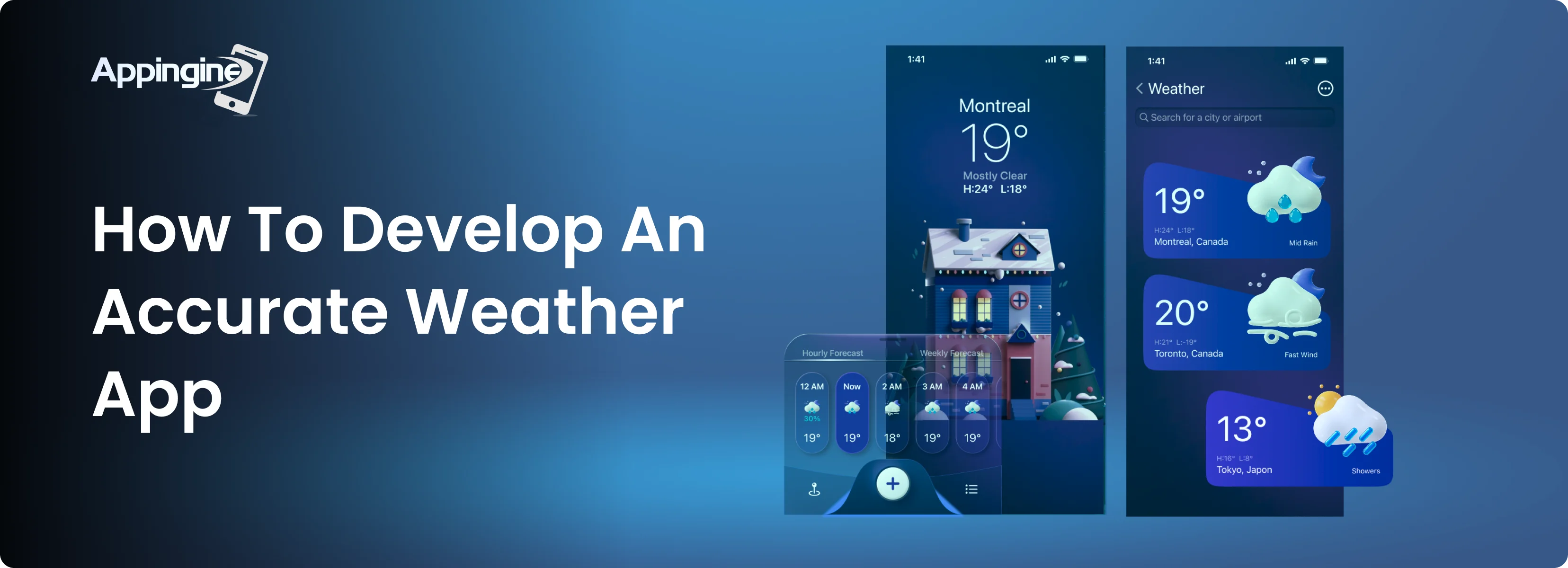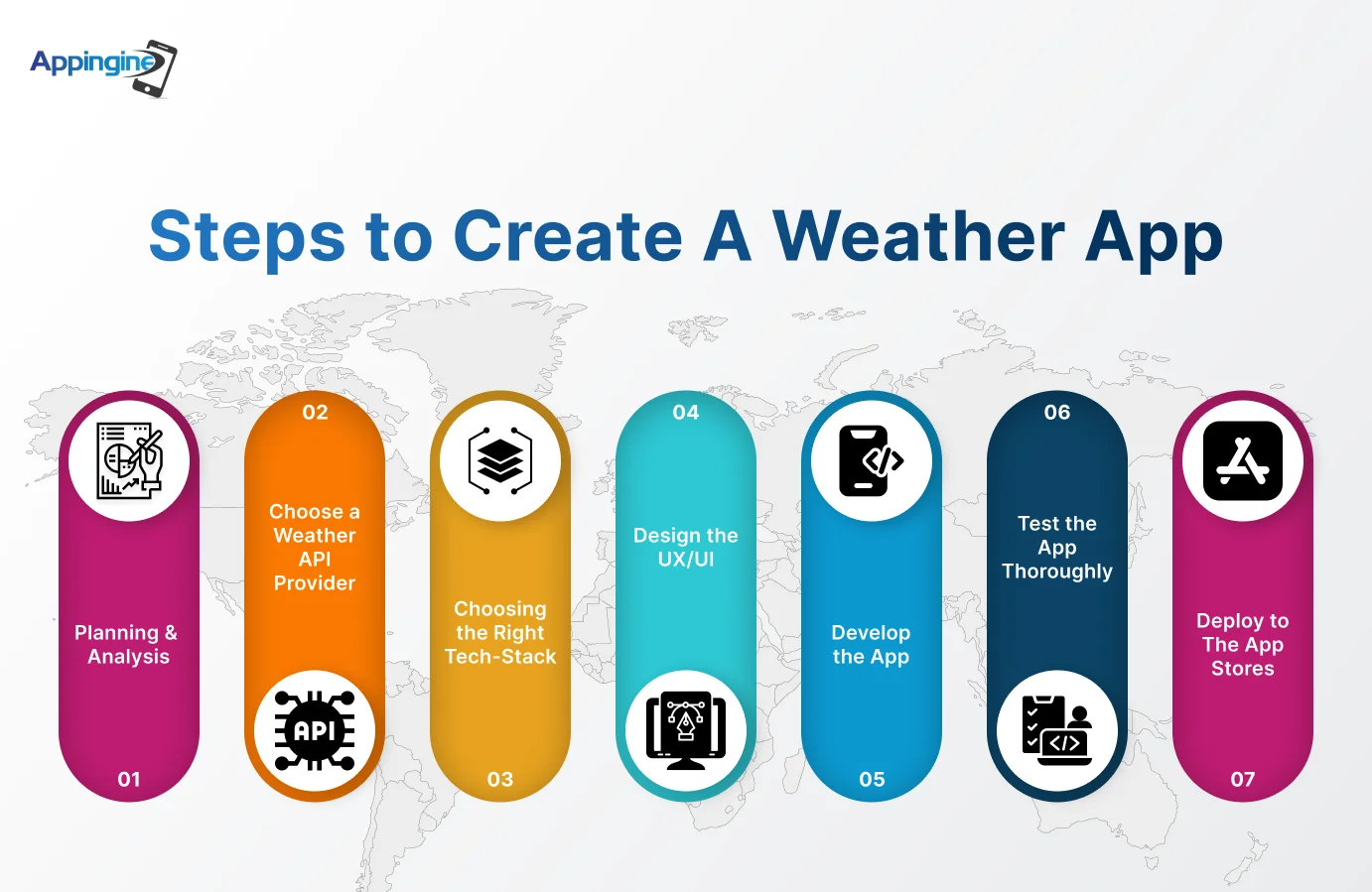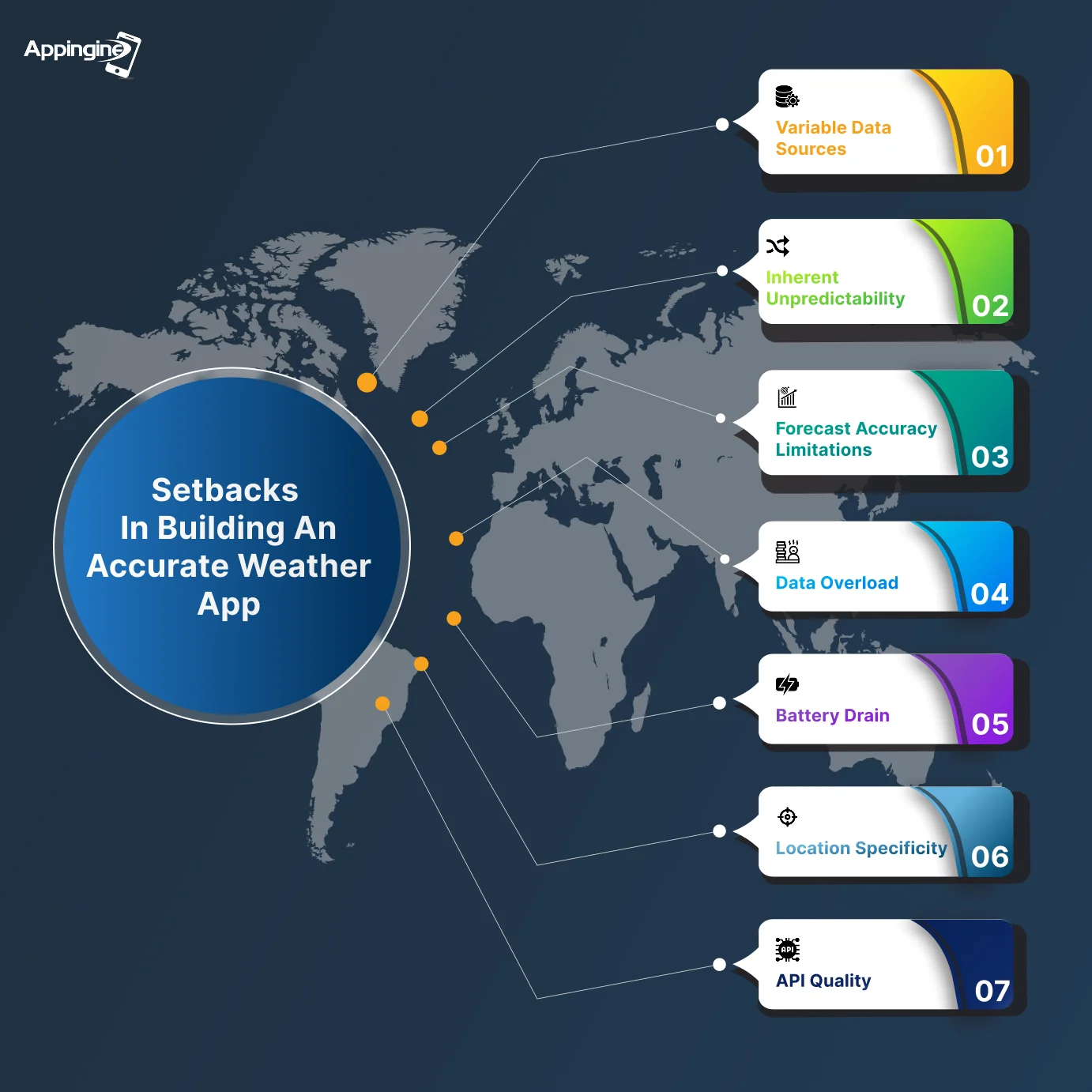Appingine
Let's Discuss Your Tech Solutions

Having a weather app in the era of advanced technology is a privilege for the users as well as developers. That helps in assisting them with day-to-day activities, outdoor events and most of all, it safeguards them during unsafe weather. These advanced applications are not merely utilities anymore, but it has become a life-saving tool for tourists, hikers, event planners and of course anyone who is not planning to soak their socks while on the way to their sports club or even favorite coffee shop.
With the advancements in technology such as artificial intelligence, advanced data modeling and several others in the competitive digital world you must know how an accurate weather app is developed, how much does it cost, and why do you need to make one. And this blog exactly answers all the above mentioned questions.
The weather app industry is poised to take the next level like never before. According to reports, it was noticed that the value had already reached $1.5 billion in 2024, and this number will rise to $2,238.3 billion by 2033. While AccuWeather leads the charge, it boasts an impressive 1.5 billion monthly active users, with the help of smart marketing strategies and seamless multi-platform integration.
The Weather Channel continues to captivate over 100 million monthly users with its trusted updates and forecasts. Its immense value was underscored when Allen Media Group acquired it for a remarkable $850 million in January 2023 while proving that precision weather forecasting remains a billion-dollar business.
But still, that one question dominates the climatic world, which app delivers the most accurate forecast? Well, accuracy is essential, then a sleek design or fancy features if you are planning to build a weather app. That is what keeps users loyal and drives downloads.
With latest technological innovations like AI-powered predictions, crowdsourced weather data and immersive AR visualizations, fresh competitors in the market such as Carrot Weather and Tomorrow.io are rewriting the forecast. These apps for weather updates are challenging giants in the market like Apple, The Weather Channel and AccuWeather by opening the skies for new developers to shine in this ever-evolving market.

By following these steps, as written by our top mobile app developers you can grasp sound knowledge on how to create a weather app for iOS & Android.
Before developing a weather app, it’s crucial to have a detailed plan and gather key insights by identifying your target audience and understanding their specific needs. Whether it’s travelers who are seeking forecasts across multiple regions or gardeners who need hyper-local data for plant care. Also, analyze market strength and value of the weather app idea that will make it easier to compete with others.
Ensure to go beyond basic forecasts, and offer more like radar imaging, live alerts, weather maps, and interactive tools, similar to how The Weather Channel keeps users engaged with clear visuals and accurate updates.
Once the list of features and functionalities are defined and clearly understood, then hop on to choosing the right tech stack among the collection available in the market. Reliable weather APIs for data integration, JavaScript for web apps, Swift for iOS, and Kotlin for Android are popular options to choose from.
Lastly, map out a realistic project timeline and budget to stay on track. Proper planning is the foundation for building a successful weather application.
Your weather app requires a dependable external data source to deliver accurate forecasts. Choose a trusted provider like OpenWeatherMap or similar services that offer reliable and up-to-date weather information. Once selected, our developers register for an API key from your chosen provider to enable seamless data integration into your app.
Choosing the right technology stack is crucial because it directly impacts the performance, scalability and user experience when developing a weather mobile app. Here is the list of technologies that are utilized by the app developers at Appingine.
Turn your weather app idea into reality through our proficient development skills
Start Developing With Appingine TodayEnsure to create a visually appealing and captivating interface by focusing on clear visuals and layout such as weather condition icons, radar animations and smooth transitions. Also, use powerful development tools like Android Studio or Xcode to design an engaging layout that enhances user experience and makes weather updates easy to understand at a glance.
To create an interactive user interface with the integration of essential features and functionalities seamlessly, work on the development of front-end code. Implement the logic to make API calls that fetch real-time weather data and display it in an intuitive format. Moreover, ensure efficient data parsing from APIs, typically in JSON or XML, to deliver accurate and visually clear weather updates.
Perform unit testing to verify the functionality of individual components and features to ensure each part of the app runs smoothly. Additionally, test the app across multiple devices and operating system versions to guarantee consistent performance, compatibility, and a seamless user experience.
Prepare your app for launch by following the submission guidelines for both the Apple App Store and Google Play Store. Once submitted for review the app will be published and now you have to closely monitor its performance, user feedback, and analytics to identify areas for improvement. Keep up with time-to-time updates to enhance functionality, fix issues, and deliver an even better user experience over time.
 When questioned about the 5 most accurate weather apps in the world, these lead the way:
When questioned about the 5 most accurate weather apps in the world, these lead the way:
| Ranking | App Name | Features | Platforms | Accuracy |
|---|---|---|---|---|
| 1 | AccuWeather | Hyperlocal, MinuteCast | Android & iOS | ★★★★★ |
| 2 | The Weather Channel | Radar, Severe Alerts | Android & iOS | ★★★★★ |
| 3 | Tomorrow.io | AI Forecasting | Android & iOS | ★★★★★ |
| 4 | Apple Weather | Dark Sky Integration | iOS Only | ★★★★☆ |
| 5 | Carrot Weather | Fun UI, Customizable | Android & iOS | ★★★★☆ |
AccuWeather app remains the gold standard for weather apps and continues its legacy of unmatched accuracy. Its signature MinuteCast feature delivers minute-by-minute precipitation forecasts specifically designed according to the exact location of the users who rely on timely updates before stepping outside. Beyond precision, the Accu weather app impresses with a sleek design, live radar maps, severe weather alerts and customizable widgets that enhance the overall experience. Moreover, if we look for the benefit of developers then its robust and dependable API provides the ideal foundation for building next-generation apps, which include those powered by augmented reality.
The Weather Channel remains one of the most trusted and recognizable weather apps worldwide, a household name especially valued during tornado and hurricane seasons for its accurate storm tracking, severe weather alerts and high-resolution radar maps. What truly distinguishes it is its strong focus on sustainability by offering climate insights and eco-friendly tips to promote environmental awareness. Plus, with seamless integration across smart TVs and wearables, The Weather Channel ensures users stay connected to timely forecasts anytime, anywhere.
Tomorrow.io is not just a weather app, it’s a powerful climate intelligence platform powered by advanced AI that delivers unmatchable forecasts while making it a top choice for industries like aviation, logistics, event management and whatnot. For everyday users, it offers hyperlocal updates, smart notifications and personalized alerts that make planning effortless by utilizing tomorrow io widget.
Is Apple’s Weather app accurate? Absolutely. With the help of Dark Sky’s hyperlocal data integration, it’s now more precise and dependable than ever. Also, with its sleek design and streamlined integration into iOS widgets, lock screens, and Siri, Apple Weather delivers an effortless user experience. Though minimalist in style, reliability and flawless performance make it a favorite among users, while becoming the best weather app for iPhone.
By turning weather forecasts into something genuinely fun while still maintaining top-tier accuracy, Carrot Weather stands out with its quirky personality and witty sarcasm. Incorporated by trusted data from sources like Dark Sky and AccuWeather, it blends humor with reliability perfectly. With customizable layouts, AI-powered insights and a wide range of interactive widgets that make it an accurate weather app, it’s an excellent choice for both Android and iOS users which offers a delightful mix of precision and entertainment that even kids can enjoy.
Well, your dream is fulfilled as you have the best developers for this job
Build Your Weather App Now!There are many obstacles in the way of creating a weather app that is actually accurate. Inconsistent data from many sources and the demanding technological burden of processing enormous datasets without exhausting user batteries are few of the collection of challenges that developers must overcome.
Moreover, gaining and maintaining the trust of users is difficult, and one incorrect prediction can result in an uninstallation very quickly. To keep people informed and confident, it's crucial to strike a balance between performance and precision along with outlining the limitations of weather prediction.
Now that we are aware of the list of challenges that the developers of the top-tier weather app development company, like, have to overcome at any cost. Here are the top trends for the experts who are looking to work on the weather app development.
Apps will increasingly use AI/ML to process vast weather-data inputs along with the improvement in the accuracy and enabling longer-range predictions. For example: hyper-local models, user-behavior adaptation, and even incorporating climate models further ahead.
For Appingine, this opens the door to developing intelligent, self-learning for the developers to gain more expertise related to weather engines or APIs that adapt in real time with local data to deliver hyper-accurate forecasts that feel personalized to every user’s location.
This trend is driven by diverse microweather, which includes urban vs suburban vs rural, and users who plan outdoor activities, logistics, and more. This means designing smart architectures and incorporating suitable APIs can process ultra-detailed spatial data, paired with a sleek UI/UX that lets users effortlessly explore micro-level forecasts, right down to their street or neighborhood.
Weather apps connecting to smart home devices, wearables, and IoT sensors have become a new trend with the advanced technology evolutions. With the passage of time and technology, weather updates are now available right on your wrist instead of your smartphone.
Now you can expand your app offerings beyond just mobile UI by thinking about the ecosystem integration (home automation, device triggers, wearables).
Visualizing weather in richer ways by taking advantage of the animated radar/satellite maps, 3D storms, AR overlays. This helps users see what’s happening rather than just reading numbers.
At Appingine, we invest in advanced UI/UX, possibly use frameworks that support mapping, AR modules, device sensors etc.
Users increasingly want weather apps that also talk about environmental impact, which includes air quality, UV index, climate trends, energy usage advice and much more. Furthermore, these apps add differentiation not just “rain or shine” but “what you can do”.
The experts suggest features like eco-alerts (“high pollution today – reduce outdoor time”), energy optimization (smart home thermostat adaptation), or climate insights.
At Appingine, the experts don’t just combine the latest technology with data-driven precision, but by taking advantage of the advanced AI model, APIs along real-time analytics, they craft weather apps that users can truly rely on. Also, they ensure every weather app forecast is as accurate as possible. Whether it is about hyper-local insights or seamless user experiences, we build weather solutions that predict more than just rain; they predict user satisfaction timelessly.
If you’re looking for a top-tier weather app development partner, we are your go-to choice. Whether it is about tracking growing conditions for farmers or analyzing solar radiation for energy companies, our expert developers build apps powered by intelligent APIs with the best weather widget that turns raw data into real insights. Let’s connect & build a weather app that’s as dynamic as the forecast itself.
To summarize, weather app development has evolved from simple forecast tools into essential assets for life-enhancing companions. Working on building a weather app is not just about coding, but it’s about encouraging the power of AI, real-time data, and smart design to keep users informed, safe, connected and captivated.
Our experts transform complex climate data into clear and actionable insights. From hyper-local forecasts to AR visualizations and IoT integrations, we are experts in developing accurate weather apps that redefine precision and reliability.
So, whether you’re helping farmers plan their crops or even guiding travelers through unpredictable skies, even empowering users to prepare for tomorrow, Appingine's future-ready development strategies have got your back.
Turn your weather app development idea into a storm of success by joining hands with Appingine today!
Let’s TalkAccuracy in a weather app is vital, which depends on high-quality data sources and powerful forecasting models, along with timely updates. At Appingine, our developers use advanced APIs and AI algorithms that process hyper-local data while ensuring every forecast feels personalized and precise.
The cost of developing a weather app varies while depending on complexity, features and platform choice. A basic app may cost around $25,000–$40,000, while feature-rich apps with AI, AR, or IoT integrations can range between $60,000–$150,000+. Appingine builds a weather app solution that is especially designed by keeping your goals and budget in mind.
Core features include real-time forecasts, radar maps, live alerts, and GPS-based location tracking. Modern weather apps also integrate AI-powered predictions, AR visualizations, voice assistants, and eco-awareness tools to enhance user engagement and reliability.
For front-end development, technologies like React Native, Swift, or Kotlin ensure seamless performance across devices. On the back end, Node.js, Django, or Ruby on Rails, combined with APIs like OpenWeatherMap, Weatherstack, or AccuWeather, provide a robust and scalable foundation.
Appingine stands out for its blend of AI innovation, real-time analytics and stunning UI/UX design. Our developers build a weather app that not only delivers accurate results of the forecast but also enhances user experience, engagement and retention. We don’t just predict the weather, we help you shape the future of forecasting.